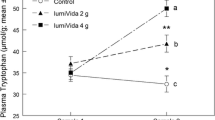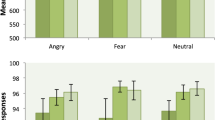Abstract
Rationale
The serotonin precursor tryptophan (TRP) has been widely used as a nutritional supplement and antidepressant. Recently, however, the use of TRP has been severely restricted due to its association with the eosinophilic myalgic syndrome, an autoimmune disorder probably caused by ingestion of a contaminant produced in certain TRP manufacturing processes.
Objectives
To determine the bioavailability of a nutritional source of TRP obtained from milk protein and to assess whether administration of this material produced neuroendocrine and neuropsychological effects consistent with increased brain serotonin activity.
Methods
We studied 24 healthy subjects who ingested approximately 1.8 g of nutritionally-sourced TRP or placebo in a double-blind, parallel group, design. We carried out venous sampling for amino acid and hormone estimation and performed a test of emotional processing using a facial expression recognition task.
Results
The nutritionally-sourced TRP caused a substantial increase in the availability of TRP in plasma. Relative to placebo the TRP material produced some evidence of an increase in plasma cortisol, and enhanced the perception of fearful and happy facial expressions.
Conclusions
A nutritional source of TRP increased the availability of TRP for brain serotonin synthesis and produced endocrine and neuropsychological changes consistent with increased brain serotonin function. The effect of TRP on emotional processing may be relevant to its reported activity in primate studies of social behaviour.



Similar content being viewed by others
References
Bender DA (1982) Biochemistry of tryptophan in health and disease. Molec Aspects Med 6:101–197
Byerley WF, Risch SC (1985) Depression and serotonin metabolism: rationale for neurotransmitter precursor treatment. J Clin Psychopharmacol 5:191–206
Cowen PJ (1993) Serotonin receptor subtypes in depression: evidence from studies in neuroendocrine regulation. Clin Neuropharmacol 16:287–296
Cowen PJ, Gadhvi H, Gosden B, Kolakowska T (1985) Responses of prolactin and growth hormone to l-tryptophan infusion: effects in normal subjects and schizophrenic patients receiving neuroleptics. Psychopharmacology 86:164–169
Ekman P, Friesen WV (1976) Pictures of facial affect. Consulting Psychologists, Palo Alto, Calif.
Furst P, Pollack TA, Graser H, Godel H, Stehle P (1990) Appraisal of four pre-column derivatization methods for the high-performance liquid chromatographic determination of free amino acids in biological materials. J Chromatogr 499:557–569
Green AR, Grahame-Smith DG (1976) Effects of drugs on the processes regulating the functional activity of brain 5-hydroxytryptamine. Nature 260:487–491
Harmer CJ, Bhagwagar Z, Perrett DI, Völlm BA, Cowen PJ, Goodwin GM (2003a) Acute SSRI administration affects emotional processing in healthy volunteers. Neuropsychopharmacology 28:148–152
Harmer CJ, Rogers R, Tunbridge E, Cowen PJ, Goodwin GM (2003b) Tryptophan depletion decreases the recognition of fear in female volunteers. Psychopharmacology DOI 10.1007/s00213-003-1401-6
Kilbourne EM, Philen RM, Kamb ML, Falk H (1996) Tryptophan produced by Showa Denko and epidemic eosinophilia-myalgia syndrome. J Rheumatol 23: 81–88
Lehnert H, Wurtman RJ (1993) Amino acid control of neurotransmitter synthesis and release: physiological and clinical implications. Psychother Psychosom 60:18–32
Moskowitz DS, Pinard G, Zuroff DC, Annable L, Young SN (2001) The effect of tryptophan on social interaction in everyday life: a placebo-controlled study. Neuropsychopharmacology 25:277–289
Raleigh M, McGuire MT (1989) Female influence of male dominance acquisition in captive vervet monkeys (Cercopithecus aethiops sabeus). Animal Behav 38:59–67
Raleigh MJ, McGuire MT, Brammer GL, Pollack DB, Yuwiler A (1991) Serotonergic mechanisms promote dominance acquisition in adult male vervet monkeys. Brain Res 559:181–190
Sharp T, Bramwell SR, Grahame-Smith DG (1992) Effect of acute administration of l-tryptophan on the release of 5-HT in rat hippocampus in relation to serotoninergic neuronal activity: an in vivo microdialysis study. Life Sci 50:1215–1223
Yatham LN, Steiner M (1993) Neuroendocrine probes of serotonergic function: a critical review. Life Sci 53:447–463
Young AW, Rowland D, Calder AJ, Etcoff NL, Seth A, Perrett DI (1997) Facial expression megamix: tests of dimensional and category accounts of emotion recognition. Cognition 63:271–313
Young SN (1986) The clinical psychopharmacology of tryptophan. In: Wurtman RJ, Wurtman JJ (eds) Nutrition and the brain, vol 7. Raven Press, New York, pp 49–88
Acknowledgements
We thank Unilever PLC for the nutritionally sourced TRP. The study was supported by an MRC Link award.
Author information
Authors and Affiliations
Corresponding author
Rights and permissions
About this article
Cite this article
Attenburrow, MJ., Williams, C., Odontiadis, J. et al. Acute administration of nutritionally sourced tryptophan increases fear recognition. Psychopharmacology 169, 104–107 (2003). https://doi.org/10.1007/s00213-003-1479-x
Received:
Accepted:
Published:
Issue Date:
DOI: https://doi.org/10.1007/s00213-003-1479-x




